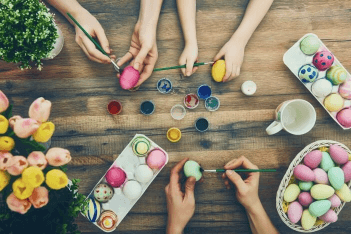
Szlifuj swój język angielski, ćwicząc na regularnie publikowanych lekcjach business English!
The topic for today is “Easter tradition and celebration”.
Task 1
Read the text below to get the general idea:
A hen or an egg? You might ask. Definitely an egg, at least at this particular time of the year. Easter is coming, hens lay eggs, chicks are hatched and hard-boiled eggs are decorated.
At Easter time, an egg, which symbolizes new life and fertility, is the king of the table. Eggs are either boiled or used as an ingredient to prepare traditional Easter dishes. When eggs are served cooked, they are usually hard-boiled. Then, they might be stuffed with varied fillings, or they might be beautifully decorated in a number of ways. Depending on the region of Poland, Easter eggs are always hand-crafted, but they can be either painted (and called ‘pisanki’), scraped (‘skrobanki’), dyed (‘malowanki’) or drawn (‘rysowanki’). They usually come in different colours, but traditionally they are covered with Easter motives or ornaments. If stuffed, the eggs are filled with varied stuffings, spreads or other popular fillings. Hard-boiled eggs are also used to prepare vegetable salads and, if raw, eggs are used to bake cakes, such as ‘mazurki’ or ‘babki’.
Eggs, in general, play an important part in Polish tradition not only at Easter time. According to folk tales and stories handed down by generations, eggs were believed to have magical powers. For instance, people used to bury eggs in fields and gardens to assure plentiful crops. Eggs hidden in the foundation of a house were supposed to ensure happiness and joy to all dwellers.
Nowadays, Easter eggs are mostly made of chocolate and are fun especially for children. In English-speaking countries, for example, Easter egg hunts or Egg rolls are organized for the youngest. Adults hide Easter chocolate eggs in gardens and kids have to look (or hunt) for them. The winner is the person who first finds and collects the biggest number of eggs. In the second game, each child is given a hard-boiled egg of a different colour and the aim is to get it intact from the starting point to the finish line. The winning egg is the one which does not crack its shell.
So, enjoy eggs in many possible ways at Easter time and on many other occasions!
Task 2
Study the text carefully and answer the questions below:
- What does an egg symbolize? ……………………………………………………………………….
- Why is an egg called the king of the table? ……………………………………………………………………….
- How are eggs cooked at Easter time?……………………………………………………………………….
- How do people serve eggs at Easter?……………………………………………………………………….
- What are other names for traditional ‘pisanki’?……………………………………………………………………….
- What is special about Easter eggs?……………………………………………………………………….
- Which cakes are associated with Easter?……………………………………………………………………….
- Why did people use to bury eggs in fields or gardens?……………………………………………………………………….
- Why did people put eggs in the foundations of their houses?……………………………………………………………………….
- What are the names of traditional Easter games for children?………………………………………………………………………..
Task 3
Watch the video Egg making… and number the sentences below in the order they appear in the video:
- Antique moulds are filled with liquid chocolate by hands. ……
- The moulds are put face up to let the chocolate set. ……
- The second time the eggs are placed face down. ……
- The eggs are artistically decorated in a number of ways. ……
- Lastly the eggs are placed on their base, then wrapped in cellophane and ribboned. ……
- The moulds are then placed on a vibrating rack to remove the excess of chocolate. ……
- When the chocolate is set, the excess is trimmed off with a knife and the moulds are removed from the eggs. ……
- Each mould is filled with a thick chocolate layer twice. ……
- A selection of fine chocolates is put inside the shell and both parts of the egg are sealed by gently melting the edges. ……
- The chocolate moves towards the edge and the shell gets a stronger rim. ……
ANSWER KEY
Task 2
1. New life and fertility.
2. Because it is an ingredient of many Easter dishes.
3. Hard-boiled.
4. As hard-boiled or stuffed with various fillings, or they are used for making salads.
5. ‘Skrobanki’, ‘malowanki’ and ‘rysowanki’.
6. They are hand-made, hand-crafted, colourful and beautifully decorated with Easter motives and ornaments.
7. ‘Mazurki’ and ‘babki’.
8. Because they believed that they would have good crops.
9. Because they believed that they would be happy and joyful.
10. Easter egg hunts and Egg rolls.
Task 3
1. 1
2. 3
3. 5
4. 8
5. 10
6. 2
7. 7
8. 4
9. 9
10. 6

